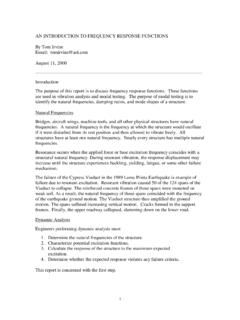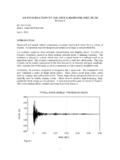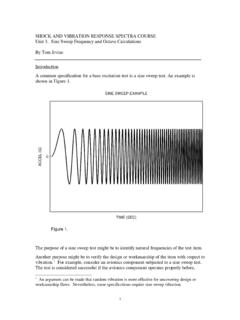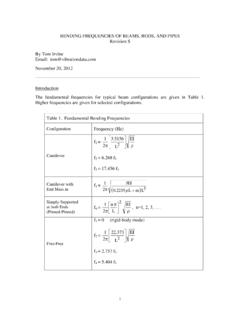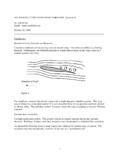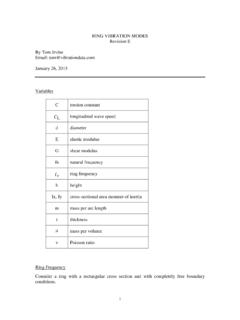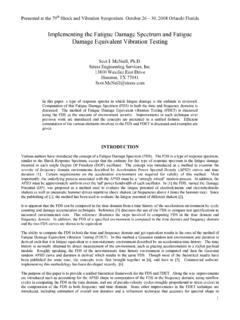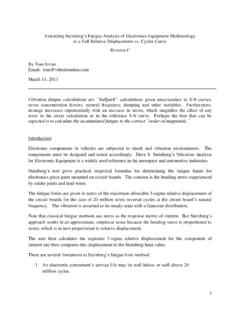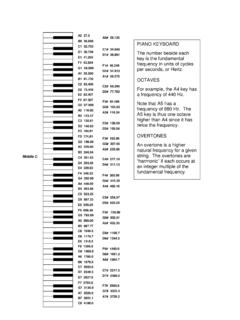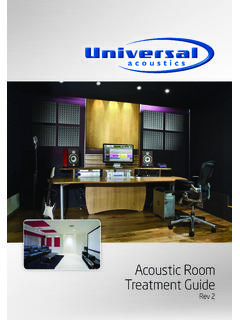Transcription of HVAC Acoustic Fundamentals - Vibrationdata
1 Application GuideAG 31-010 Engineered for flexibility and performance. hvac Acoustic PressureBarrierPath Length DifferenceMeasurement PointBHBDS1R12 Application guide AG 31-010 Table of ContentsTable of Contents .. 2 Introduction .. 4 Using This Manual .. 4 Sound Basics .. 5 General .. 5 Wavelength and 6 Decibels .. 6 Sound Pressure vs. Sound 7 Octave 7 Human Response to Sound .. 8 Sound Pressure Evaluation Criteria .. 9 Acceptable Sound Levels .. 14 Sound Testing Methods .. 15 hvac Equipment 16 Calculating Sound Pressure from Sound Power .. 16 Outdoor Sound 22 General .. 22 Outdoor Sound Analysis 22 Open Field 23 Sound Barriers .. 24 Reflecting 27 Indoor Sound Analysis Zoned Comfort Systems .. 29 General .. 29 Sound in a Room .. 29 Room Constant and Sound Absorption Coefficient .. 29 Thompson and Schultz 32 Indoor Sound Analysis Ducted Zoned Comfort Systems.
2 36 Radiated and Discharge Sound Power ..36 Multiple Path Concept .. 36 Duct Sound Path .. 37 Converting Ducted Sound Power to Sound Pressure .. 41 Duct Breakout Sound Path .. 44 Return Air Sound Path .. 48 Diffuser Sound 50 Radiated Sound 52 Evaluating All the Sound 53 Indoor Sound Analysis Central Systems .. 54 General .. 54 Multiple 54 Central System Duct Sound Path .. 55 Transmitted 64 Main Duct Breakout .. 70 Return Air Path .. 72 Evaluating Multiple Sound Paths and Locations .. 75 Regenerated 76 General .. 76 Evaluating Regenerated 76 Conclusions .. 78 Appendix 1 - References .. 79 Appendix 2 hvac Equipment Sound Measurement Stds .. 80 General .. 80 Appendix 3 Various Acoustic Properties of Materials .. 81 General .. 81 Application guide AG 31-0103 The data and suggestions in this document are believed current and accurate at the time ofpublication, but they are not a substitute for trained, experienced professional applications and site variations can significantly affect the results andeffectiveness of any information, the reader must satisfy him/herself regarding theapplicability of any article and seek professional evaluation of all materials.
3 McQuaydisclaims any responsibility for actions based on this guide AG 31-010 Tip; In this manual, Sound Pressure will be indicatedby Lp RE 10-12 Pa, while Sound Power will be indicatedby Lw RE 10-12 comfort is the goal of all hvac designers. Sound (or noise) is a key parameter inmeasuring comfort, in addition to temperature, humidity and Indoor Air Quality (IAQ). Whileacoustics consultants are usually involved in critical applications (such as performing arts centers),the task of creating a comfortable Acoustic environment in most other applications falls on the hvac engineer. This is because most background sound sources are generated by the hvac purpose of this manual is to familiarize the designer will the basics of acoustics, and to applythese basics to typical hvac This ManualThe manual can be used as an application guide or as a primer for using the McQuay AcousticAnalyzer software program.
4 The equations and approach described herein were used in thecreation of the Acoustic Analyzer program. Small differences can exist between the software and themanual because the Acoustic Analyzer program uses equations to estimate values as opposed to thetables listed in the manual. However, the difference in values will be very that show how to perform some analyses are included in double lined boxes. Helpful tipsare also provided. Tips box exampleInformation in double linedboxes show calculationexamplesDecibel ExampleCalculate the loudest possiblesound at standard atmosphericpressure ( kPa)Lp = 20 Log(101,300 )= 194 dB RE 20 PaNote: 20 Pa is another way towrite guide AG 31-0105 Sound BasicsGeneralSound is defined as a disturbance in an elastic medium that can be detected by the human ear. Themedium can be gas, liquid or solid.
5 Noise is undesirable sound or sound without value. The pressurewaves (or sound) act on the inner ear, which is what we hear. The best sound is not necessarily nosound. In an open office concept, background sound offers privacy for conversations. The quality ofsound is also important. Tonal sounds are usually not following list will help better understand 1- Typical Sound Pressure Levels The amplitude of the sound waverepresents the loudness and ismeasured in decibels (Pascals). Thelouder the sound, the larger theamplitude. The loudest atmosphericsound has zero atmospheric pressureat the low point and two timesatmospheric pressure at the highpoint. This is 194 dB. The frequency of sound representsthe pitch and is measured in higher the frequency, the higherthe sound.
6 The human hearing rangeis from about 16 Hz to 16,000 30 Hz, sound can be felt aswell as heard. The wavelengths for sound can vary from 70 feet ( m) at 16 Hz to feet ( m) at16,000 Hz. This is important because sound absorbing materials tend to work well when theirdimensions are close to the wavelength. Therefore, a 1-inch (25 mm) ceiling tile is effective atabsorbing higher frequency sounds, but low frequency sounds are much more difficult toattenuate. The human ear can respond to very wide range of sound levels. At the low end, the ear issensitive to sound pressure waves as little as Pa. At the high end, the human ear can hearabout 20 Pa without pain, which is 1,000,000 times louder. This is a key reason why Decibellogarithmic scales are used.
7 The speed of sound is dependent on the density of the medium it is travelling through. The lowerthe density, the slower the sound wave. At standard atmospheric conditions, the speed of sound(Mach 1) is 764 miles per hour (1120 feet per second, 341 m/s). Sound waves do not actually pass through walls or other solid objects. Instead, they impinge onthe exterior surface of the wall or object, causing it to vibrate. This, in turn, causes the airmolecules in the space to vibrate. What is actually happening is that the sound wave is makingthe wall or object move! Pressure6 Application guide AG 31-010 Wavelength and FrequencyThe wavelength of sound in air is given by;Eq. 1 = co /fWhere is the wavelength in feet (m).co is the speed of sound, which is 1120 feet per second(341 m/s) at sea is the frequency in very large range in sound pressure makes a logarithmicscale more convenient.
8 Decibels (dB) are always referencedto base signal. Knowing the base reference is criticalbecause the term decibels in acoustics is used for soundpressure and sound power. In the case of sound pressure,the reference is Pascals, which is the threshold ofhearing. Eq. 2Lp = 20 Log( )WhereLp is the sound pressure in Decibels (dB)P is the sound pressure in sound power the reference is 10-12 3Lw = 10 Log(W/10-12 )WhereLw is the sound power in Decibels (dB)W is the sound power in WattsDecibel Addition and SubtractionSince Decibels are logarithmic, they cannot simply beadded. For instance, 40 dB + 40 dB is not 80 dB, it is 43dB. Decibels can be added as follows:Eq. 4Ls = 10 Log(10L1/10 + 10L2/10+10L3/10+..)Decibels can be quickly added together with an accuracy ofabout 1 dB by using the relationship shown in Table 1-Decibel Addition ExampleCalculate the loudest possiblesound at standard atmosphericpressure ( kPa)Lp = 20 Log(101,300 )= 194 dB RE 20 PaNote: 20 Pa is another way towrite Addition ExampleAdd the follow values together.
9 L1 = 80 dBL2 = 82 dBL3 = 84 dBL4 = 93 dBL5 = 72 dBLTo t a l = 10 Log(1080/10 +1082/10+1084/10 + 1093/10+1072/10) = 94 dBUsing Table 1- DecibelAddition ChartBetween L1 and L2, there is adifference of 2 dB so add 2 dBto L2 for a total of 84 84 dB and L3, there isa difference of 0 dB so add 3dB to 84 dB for a total of 87 dB and L4, there isa difference of 6 dB so add 1dB to L4 for a total of 94 94 dB and L5, there isa difference of 22 dB so add 0dB to 94 dB for a total of 94 guide AG 31-0107 Tip; In this manual, Sound Pressure will be indicatedby Lp RE 10-12 Pa and Sound Power will be indicated byLw RE 10-12 1- Decibel Addition ChartDecibel subtraction is accomplished as follows:Eq. 5Ls = 10 Log(10L1/10 - 10L2/10-10L3 )Sound Pressure vs. Sound PowerWhat you hear is sound pressure. It is the fluctuation in the atmospheric pressure that acts on youreardrum.
10 However, sound pressure is dependant on the surroundings, making it a difficult means tomeasure the sound level of equipment. Sound power is the sound energy released by a sound cannot be heard , but it can be used to estimate the sound pressure levels if the space conditionsare pressure and sound power are best explained with an example. Consider a 5 kW electricbaseboard heater. The 5 kW rating is a clear, definable measure that can be used to compare oneheater against another. This is the equivalent of Sound Power. However, it not possible to knowwhether a 5 kW heater is sufficient to keep the occupant warm and comfortable unless thetemperature of the space is known. The temperature of the space is the equivalent of sound the 5 kW heater is used in a small, single room addition to a house, it will probably provide acomfortable temperature.
